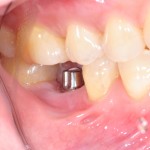
The use of dental implants is becoming an increasingly common procedure. Traditionally they have been placed after a mucoperiosteal flap has been raised. The concept of implants placement without raising a flap (flapless surgery) has been advocated as a way of achieving a shorter treatment time. The aim of this review was to evaluate the outcomes of flapless surgery for implants placed with free-hand or guided surgical methods, the latter either with or without 3D navigation.
Searches were undertaken in PubMed for randomised controlled clinical trials (RCTs), controlled trials, prospective and retrospective studies with a minimum for up period of 1 year in English or German. Study identification and selection and data abstraction was undertaken independently by two reviewers. A qualitative summary was presented.
- 23 studies were included (1 RCT, 14 prospective studies, 8 retrospective studies )
- There was significant heterogeneity because of different loading protocols, implant systems, navigation systems, reconstructive approach and settings. There was also a lack of standardization of reporting with regard to the success of the implants.
- Free-hand flapless surgery had survival rates between 98.3% and 100% and mean marginal bone loss between 0.09 and 1.40 mm at 1–4 years after implant insertion.
- Flapless guided surgery without 3D navigation had survival rates between 91% and 100% and mean marginal bone loss of 0.89 mm after an observation period of 2–10 years.
- The survival rates and mean marginal bone loss for implants placed with 3D guided flapless surgery were 89–100% and 0.55–2.6 mm, respectively, at 1–5 years after implant insertion.
- In 17 studies, surgical and technical complications such as bone perforation, fracture of the surgical guide, and fracture of the provisional prosthesis were reported.
The authors concluded
The literature suggests several methods to facilitate implant placement via a flapless approach. However, none of the identified methods has demonstrated advantages over the others.
Comment
As only a single database was searched this is not technically a systematic review as a minimum of two databases should be searched. Consequently it is possible that some relevant studies were not identified. The authors note considerable heterogeneity between the identified studies and not formal assessment of quality has been presented. While good survival rates have been presented the results should be interpreted with caution. The 2012 Cochrane review by Esposito et al also sought to address the use of flapless procedures. At the time they concluded:-
There is limited weak evidence suggesting that flapless implant placement is feasible and has been shown to reduce patient postoperative discomfort in adequately selected patients, that augmentation at implant sites with soft tissue grafts is effective in increasing soft tissue thickness improving aesthetics and that one technique to increase the height of keratinised mucosa using autografts or an animal-derived collagen matrix was able to achieve its goal but at the price of a worsened aesthetic outcome (0.5 mm of recession). There is insufficient reliable evidence to provide recommendations on which is the ideal flap design, the best soft tissue augmentation technique, whether techniques to increase the width of keratinised/attached mucosa are beneficial to patients or not, and which are the best incision/suture techniques/materials. Properly designed and conducted RCTs, with at least 6 months of follow-up, are needed to provide reliable answers to these questions.
As this new review only included one RCT that was included in the earlier Cochrane review there is clearly a need for more well conducted high quality trials to answer this question.
Links
Voulgarakis A, Strub JR, Att W. Outcomes of implants placed with three different flapless surgical procedures: A systematic review. Int J Oral Maxillofac Surg. 2013 Nov 27. pii: S0901-5027(13)01163-6. doi: 10.1016/j.ijom.2013.10.024. [Epub ahead of print] PubMed PMID: 24290308.
Esposito M, Maghaireh H, Grusovin MG, Ziounas I, Worthington HV. Interventions for replacing missing teeth: management of soft tissues for dental implants. Cochrane Database of Systematic Reviews 2012, Issue 2. Art. No.: CD006697. DOI: 10.1002/14651858.CD006697.pub2.
